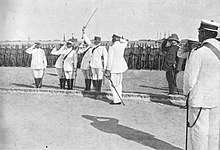
The Italo-Turkish or Turco-Italian War was fought between the Kingdom of Italy and the Ottoman Empire from 29 September 1911, to 18 October 1912. As a result of this conflict, Italy captured the Ottoman Tripolitania Vilayet, of which the main sub-provinces were Fezzan, Cyrenaica, and Tripoli itself. These territories became the colonies of Italian Tripolitania and Cyrenaica, which would later merge into Italian Libya.

Omar al-Mukhṭār Muḥammad bin Farḥāṭ al-Manifī, called The Lion of the Desert, known among the colonial Italians as Matari of the Mnifa, was an Imam and leader of native resistance in Cyrenaica under the Senussids, against the Italian colonization of Libya. A teacher-turned-general, Omar was a prominent figure of the Senussi movement and he is considered the national hero of Libya and a symbol of resistance in the Arab and Islamic worlds. Beginning in 1911, he organised and led the Libyan resistance movement against the Italian colonial empire during the First and Second Italo-Senussi Wars. Externally, he also fought against the French colonization of Chad and the British occupation of Egypt. After many attempts, the Italian Armed Forces managed to capture Al-Mukhtar near Slonta when he was wounded in battle by Libyan colonial troops, and hanged him in 1931 after he refused to surrender.
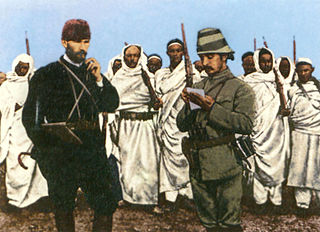
The Battle of Tobruk (1911) or Nadura Hill Battle occurred on 22 December 1911 during the Italo-Turkish War. The battle was a small engagement primarily known for the involvement and leadership of future Turkish president Mustafa Kemal Atatürk.

Benedetto Brin was a Regina Margherita-class pre-dreadnought battleship built for the Italian Regia Marina between 1899 and 1905. The ship was armed with a main battery of four 12-inch (300 mm) guns and was capable of a top speed of 20 knots. Benedetto Brin saw combat in the Italo-Turkish War of 1911–1912, including the bombardment of Tripoli in October 1911. She was destroyed by an internal explosion during World War I in September 1915, which killed over 450 of the ship's crew.
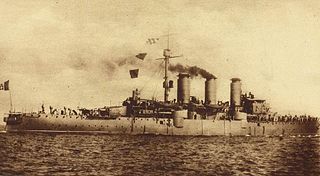
Amalfi was a Pisa-class armored cruiser of the Italian Royal Navy built in the first decade of the 20th century. During the Italo-Turkish War of 1911–1912, Amalfi operated with the Italian fleet off Tripoli in September 1911 and participated in the amphibious landings at Derna in October. In April 1912, Amalfi and sister ship Pisa led the way in attacks on Turkish forts in the Dardanelles. After the rest of the fleet retired later in the month, the pair of armored cruisers remained in the area to attack Turkish communications facilities. After the Treaty of Lausanne signed in October 1912 ended the war, Amalfi escorted the Italian king and queen on the royal yacht to Germany and Sweden during a 1913 visit.

Giuseppe Garibaldi was the 7th ship of the Giuseppe Garibaldi class of armored cruisers built for the Royal Italian Navy in the 1890s. She was built to replace lead ship of her class, which was sold to Argentina and renamed the ARA Garibaldi. The ship often served as a flagship and made several deployments to the Eastern Mediterranean and the Levant during her career. At the beginning of the Italo-Turkish War of 1911–12 she bombarded Tripoli. Giuseppe Garibaldi bombarded Beirut in early 1912 and sank an Ottoman ironclad there. Several months later she bombarded the defenses of the Dardanelles.
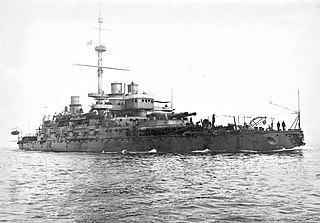
Sicilia was the second of three Re Umberto-class ironclad battleships built for the Italian Regia Marina. The ship, named for the island of Sicily, was laid down in Venice in November 1884, launched in July 1891, and completed in May 1895. She was armed with a main battery of four 343 mm (13.5 in) guns and had a top speed of 20.3 knots, though this high speed came at the cost of armor protection.

The Battles of Zanzur or Battles of Janzur, were a series of battles that took place in 1911–1912 at Zanzur oasis, near Tripoli during the Italo-Turkish War. During the battles, the Italians unsuccessfully attacked the Turkish-Arab stronghold located approximately twelve miles from the Italian lines at Tripoli until finally achieving a victory on 20 September 1912.

Agordat was a torpedo cruiser of the Italian Regia Marina built in the late 1890s. She was the lead ship of the Agordat class, which had one other member, Coatit. The ship, which was armed with twelve 76 mm (3 in) guns and two 450 mm (17.7 in) torpedo tubes, was too slow and short-ranged to be able to scout effectively for the fleet, so her career was limited. She saw action during the Italo-Turkish War in 1911–1912, where she provided gunfire support to Italian troops in North Africa. She assisted in the occupation of Constantinople in the aftermath of World War I, and in 1919 she was reclassified as a gunboat. In January 1923, Agordat was sold for scrapping.
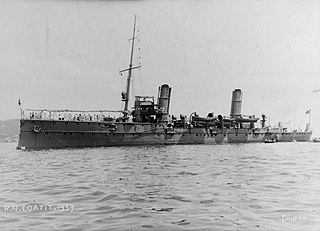
Coatit was a torpedo cruiser of the Italian Regia Marina built in the late 1890s. She was the second and final member of the Agordat class. The ship, which was armed with twelve 76 mm (3 in) guns and two 450 mm (17.7 in) torpedo tubes, was too slow and short-ranged to be able to scout effectively for the fleet, so her career was limited. She saw action during the Italo-Turkish War in 1911–1912, where she provided gunfire support to Italian troops in North Africa. She also caused a minor diplomatic incident from an attack on retreating Ottoman soldiers in Anatolia. Coatit was part of an international fleet sent to Constantinople when the city appeared to be at risk of falling to the Bulgarian Army during the First Balkan War. In 1919, she was converted into a minelayer and was sold for scrap in 1920.

Vincenzo de Feo was an Italian Admiral. He served as Governor of Italian Eritrea during 1937.

The battle and massacre at Shar al-Shatt occurred on 23 October 1911 in the village of Shar al-Shatt on the outskirts of Tripoli, Libya during the Italo-Turkish War. 378 Italian officers and men were killed in the fighting and the massacre of soldiers who had surrendered. The incident became known as the "Massacre of Italians at Sciara Sciat."

Iride was a torpedo cruiser of the Partenope class built for the Italian Regia Marina in the 1880s. Laid down in February 1889 at the Regio Cantiere di Castellammare di Stabia shipyard, she was launched in July 1890 and was commissioned in November 1892. Her main armament were her six torpedo tubes, which were supported by a battery of ten small-caliber guns. Iride spent most of her career in the main Italian fleet, where she was primarily occupied with training exercises. During the Italo-Turkish War in September 1911, she remained in Italian waters until late in the conflict; she escorted a troop convoy to North Africa in April 1912 and bombarded Ottoman positions in June and July. Iride was eventually broken up for scrap in December 1920.
Events from the year 1911 in Italy.
Events from the year 1912 in Italy.

The Battle of Benghazi occurred during the Italo-Turkish War when the Kingdom of Italy attacked and took possession of the major cities of the Ottoman Empire's North African Tripolitania province, now Libya. Benghazi was one of the five strategic cities captured and held by the Italians during the entire length of the war.

Luigi Sansonetti was an Italian admiral during World War II.
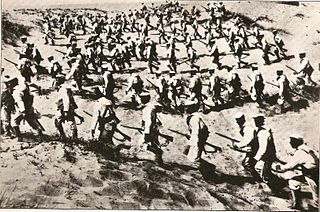
The Battle of Tripoli was fought in October 1911, during the initial stages of the Italo-Turkish War, and saw the capture of Tripoli, capital city of Tripolitania, by Italian landing forces. It marked the beginning of the land campaign in Libya of the Italo-Turkish War as well as the beginning of the Italian colonization of Libya.

Arturo Corrado Luigi Triangi, Conte di Maderno e Laces was an Italian admiral. He was also a member of the Senate and briefly Minister of the Navy in the Boselli government. A count of the Holy Roman Empire, his title was officially recognised in Italy by a ministerial decree of 8 April 1925.

